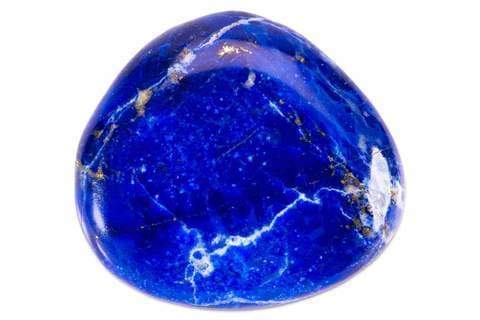Lapis lazuli
Properties of lapis lazuli
Lapis lazuli is a well-known ornamental stone used in jewelry and decoration worldwide. Its blue color varies in intensity depending on the density of lazurite, its main component. The most precious lapis lazuli stones have a deep blue color streaked with golden pyrite highlights. It should be noted that an excess of pyrite or calcite, another white component of lapis lazuli, tends to diminish the quality and value of the stone.
The main lapis lazuli deposits are located primarily in northern Afghanistan, in the province of Badakhshan. The Darreh-Zu mine is said to produce the most coveted stones. Other deposits exist around the world, such as those in Chile, Canada, the United States, Angola, and Russia. However, lapis lazuli mined in these countries tends to be a lighter blue and, therefore, of lower quality than that from Afghanistan.
History of lapis lazuli
Etymologically, lapis lazuli is composed of the Latin word lapis lazuli, meaning stone, and the word lazuli, derived from the Persian lâdjaward, meaning azure. The use of lapis lazuli dates back to the dawn of time, more than 7,000 years ago. The stone has been mentioned in famous myths such as the Epic of Gilgamesh in Mesopotamia. It adorned sarcophagi and jewelry in ancient Egypt, as well as ornaments in the Persian Empire. There are even references to lapis lazuli in the Bible, further evidence of the value of this unique stone throughout the centuries.
Modern archaeology clearly shows that the lapis lazuli trade was highly developed and widespread from antiquity. The monopoly on this trade was the subject of continuous wars between the city-states of Mesopotamia. This demonstrates the importance of this stone in the daily life of the time and its impact on the prestige, refinement, and wealth of this civilization.
Discover our lapis lazuli bracelet

In the city of Our, for example, in southern Mesopotamia, excavations have uncovered tombs attributed to kings and notables containing rich lapis lazuli objects such as statuettes depicting animals or deities, cylinder seals, or richly decorated jewelry made from this stone.
The name of lapis lazuli has changed considerably over the years. In ancient Rome, Pliny called this blue, gold-flecked material sapphire, primarily due to the golden traces of pyrite. Later, the stone was known as ultramarine and lazur, the latter being the origin of the French word azure.
Benefits of lapis lazuli
The uses of lapis lazuli have varied over time, including its aphrodisiac properties in Roman times, its benefits for strengthening organs and limbs, and its preventative effects against fear, doubt, and envy in the Middle Ages.
Lithotherapy attributes undeniable virtues to lapis lazuli in the human body, especially when it comes to resolving skin, scalp, and vision problems. Lapis lazuli is also known to have a beneficial effect on reducing fever and high blood pressure and nervous tension. The energetic properties of lapis lazuli can effectively remedy sore throats, migraines, dizziness, as well as insomnia, circulatory disorders, and certain types of allergies.
A quintessential calming stone, lapis lazuli is ideal for combating depression. Lapis lazuli elixir is particularly recommended for overcoming shyness and a lack of self-confidence. It is the remedy for introverts seeking to stimulate their communication skills and enhance their self-expression, helping them overcome their limitations.
Discover our Metatron Lapis Lazuli Orgonite Pendant

While fostering communication and empathy by stimulating positive feelings of love and friendship, lapis lazuli is also a stone for understanding oneself and others and for harmonizing human emotions. Favorable to wisdom and meditation, it is a formidable tool for extrasensory awakening, helping to better recall dreams and especially to see their hidden meaning and decipher their often cryptic messages.
In astrology, lapis lazuli is particularly favorable to the signs of Aquarius, Pisces, and Sagittarius. The planets associated with lapis lazuli are Mercury and Jupiter. Its lucky day is Wednesday.
At the karmic level, lapis lazuli acts on the crown chakra and the third eye; its action is primarily at the level of the upper chakras.



















